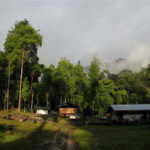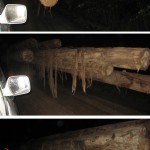Wild Cuckoo Chase Pt.III
Read Part I and II first
Department Admits Logging Disaster’. That was the headline in the Sabah Daily Express the morning after the Sabah Society talk. It seems that the question and answer session at the end of the talk was dominated by discussion of an environmental crisis which had been unfolding for some time in the Ulu Segama Forest Reserve. It is uncharacteristically frank for a politician to admit to a ‘disaster’ and to give him credit the gist of the message appeared to be; ‘it’s a fair cop Guv, please go easy on us and we’ll promise not to do it again’.
The Ulu Segama Forest Reserve is managed by Yayasan Sabah for commercial timber harvesting. It almost completely encircles the Danum Valley Conservation Area and includes much of the catchment of the Segama River. Unsustainable logging practices have been prevalent in this reserve since the 1960’s but had intensified as the deadline to phase out all logging by the end of 2007 approached. The hardest hit area is known as North Ulu Segama and comprises 12,000ha of virtually clear-cut forest. Environmental refugees, famously orang-utans, have been unable to escape their decimated habitat due to being hemmed in by Oil Palm plantations to the north and the Segama River to the south.
Notwithstanding the environmental tragedy, the public interest of this case is that the Ulu Segama region is subject to a Sustainable Forest Management License Agreement (SFMLA). In other words Yayasan Sabah are contractually bound to manage this forest sustainably. The admission of an ‘Environmental Disaster’ by Sabah Forestry Department suggests that the SFMLA had been broken. Technically Yayasan Sabah can be sued for mismanagement and although this is unlikely to happen, at least the public now have evidence that their forest reserves are not managed as sustainably as it is claimed.
The other ‘successful’ outcome of the Sabah Society talk was that my ‘press release’ style email was mistakenly read out as a question to the Director of Forestry. In this email I had focused on the fact that proposed logging coupes near Imbak did not respect either the Imbak buffer zone or the presence of the Research Station and proposed Studies Centre. The Director’s response was to deny all knowledge of research activities near Imbak Canyon and in doing so suggest that the Conservation Division were not being transparent.
This of course was the incident to which my client referred in our meeting. As awkward as it was I knew that I had to explain myself immediately. My confession was taken curiously and on leaving the meeting I had the feeling that a re-appraisal had occurred, both of me and of the situation. Now that the dust has settled it looks as though the Imbak Studies Centre site and adjacent research plots will be spared the chainsaw, although how this will affect the viability of the proposed Studies Centre remains to be seen.






